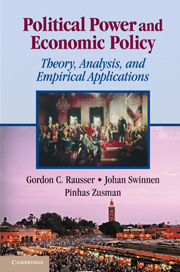Book contents
- Frontmatter
- Contents
- List of Figures
- List of Tables
- Preface
- PART 1 POLITICAL POWER AND ECONOMIC ANALYSIS
- 1 Public Policy: The Lens of Political Economy
- 2 The Nash Solution to the Bargaining Problem
- 3 The Harsanyi Solution to the Bargaining Problem
- 4 Political-Economic Analysis
- 5 Normative Political-Economic Analysis
- 6 Dynamic Political-Economic Analysis
- PART 2 IDEOLOGY, PRESCRIPTION, AND POLITICAL POWER COEFFICIENTS
- PART 3 ANALYSIS OF SPECIFIC STRUCTURES
- PART 4 EMPIRICAL APPLICATIONS OF POLITICAL POWER ESTIMATION
- References
- Index
3 - The Harsanyi Solution to the Bargaining Problem
Published online by Cambridge University Press: 05 June 2012
- Frontmatter
- Contents
- List of Figures
- List of Tables
- Preface
- PART 1 POLITICAL POWER AND ECONOMIC ANALYSIS
- 1 Public Policy: The Lens of Political Economy
- 2 The Nash Solution to the Bargaining Problem
- 3 The Harsanyi Solution to the Bargaining Problem
- 4 Political-Economic Analysis
- 5 Normative Political-Economic Analysis
- 6 Dynamic Political-Economic Analysis
- PART 2 IDEOLOGY, PRESCRIPTION, AND POLITICAL POWER COEFFICIENTS
- PART 3 ANALYSIS OF SPECIFIC STRUCTURES
- PART 4 EMPIRICAL APPLICATIONS OF POLITICAL POWER ESTIMATION
- References
- Index
Summary
Introduction
In this chapter, we introduce several generalizations to the formulation and solution of the bargaining problem. Until the early 1960s, the study of social power (including political power) had been carried out exclusively by sociologists. That changed in 1962, when Harsanyi managed to introduce the rigor of mathematical reasoning into the theory of social power by applying the analytical tools and models of game theory. Harsanyi provided a clear interpretation that eliminated much of the ambiguity that had previously plagued the theory of social power (Harsanyi 1962a, 1962b).
Chapter 2 focused on Nash's original two-person bargaining problem, which treats the bargaining parties' conflict or disagreement payoffs as given. This formulation suffers from two important drawbacks in the context of political policy formation. First, in many real-world cases, the threats can actually be decided by the parties themselves. Nash himself recognized this, and in a 1953 paper he presented a model in which the determination of the threat payoff is the reflection of the parties' strategic choices. In Section 3.2 of this chapter, we present this more general model.
Second, Nash's original formulation of the bargaining problem dealt exclusively with the two-person bargaining problem. However, in the real world the number of bargaining parties exceeds two more often than not. This is particularly true of public policy negotiation analyses. When there are more than two parties involved in the bargaining, alternative coalition formations are always possible. Many political-economic models take the coalitions as given.
- Type
- Chapter
- Information
- Political Power and Economic PolicyTheory, Analysis, and Empirical Applications, pp. 50 - 63Publisher: Cambridge University PressPrint publication year: 2011

